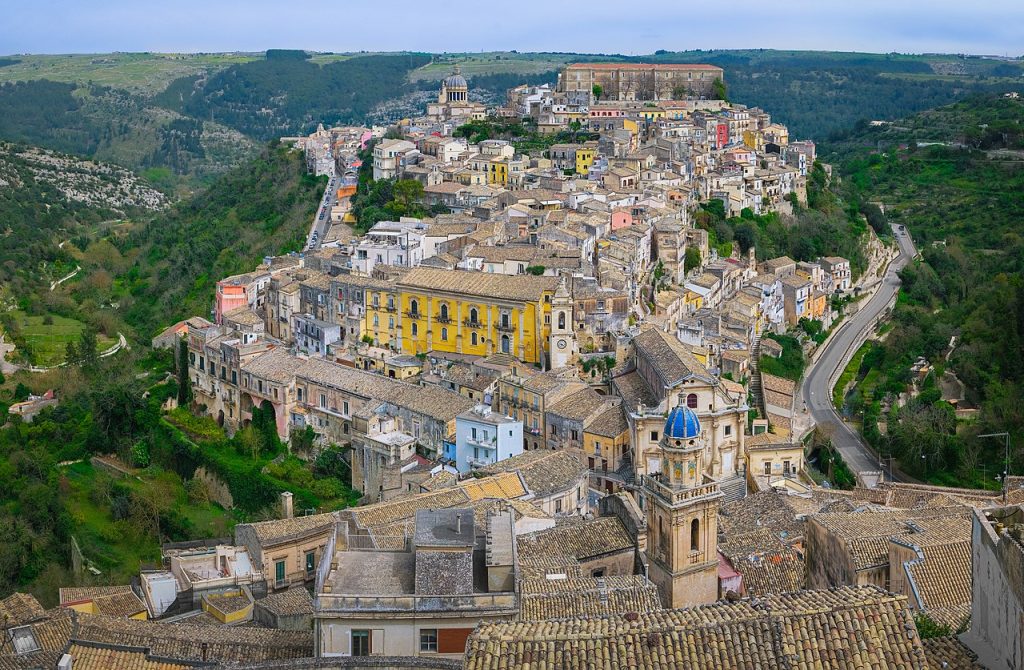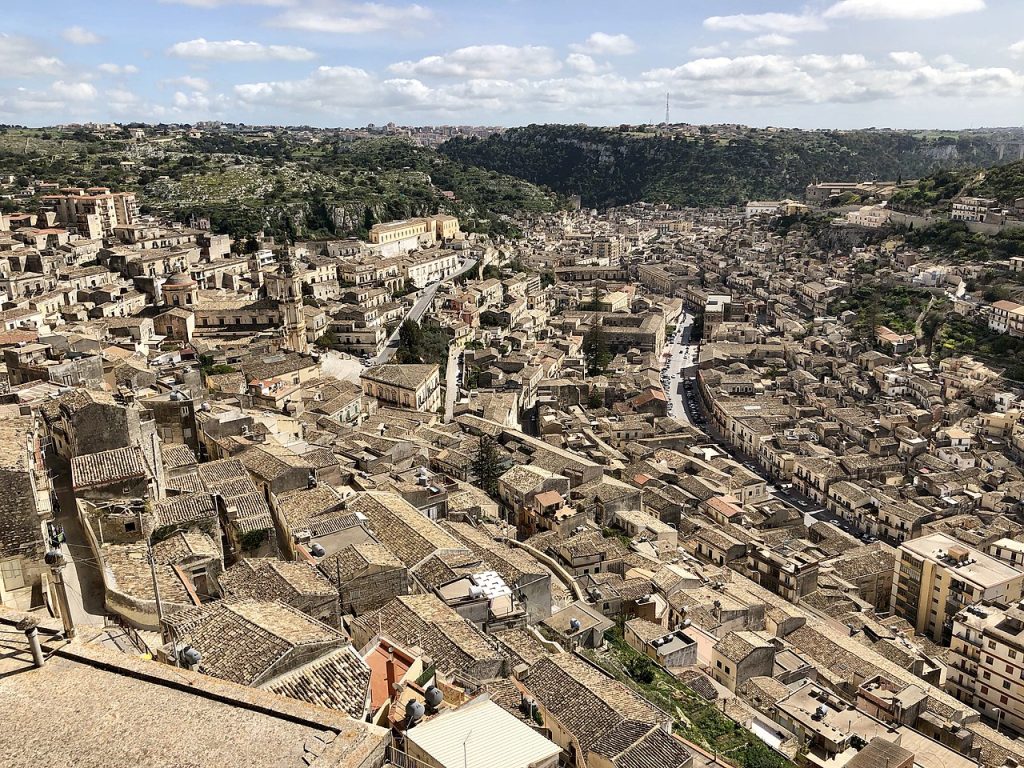Scicli is a monumental baroque city town and since 2002 its city centre became a UNESCO heritage. Scicli became famous thanks to the
“Il Commissario Montalbano” fiction, where the municipality was converted in Police station and the Mayor office became the police commissioner’s room in the unreal Vigata.
Scicli is a “diamond in Val di Noto Baroque”, also thanks to its little houses all attached and its narrow streets. The weather, more or less all the year, the richness of Sicilian cuisine with tasty and genuine dishes, the shops in which you could lost, the proximity with the sea area, make unforgettable the tour in this smart Sicilian city!
Scicli arises in the intersection between three Valleys: Modica Valley, Santa Maria la Nova Valley and San Bartolomeo Valley, known under the definition of Quarries. Scicli involves 20 km of sea cost, including Donnalucata, Playa Grande, Cava d’Aliga, Arizza and Sampieri. Scicli offers us fascinating landscape and, at the same time, in contrast between them.
In the past, the old town was built in Saint Matthew hill. It was a strategic position also because with its towers and castles was a fortify city. Furthermore, the city had a below area which arrived till the sea cost; from this area were born all the little actual urban poles.
Scicli is full of festivals and religious celebrations, always linked to the past and enriched by the creativity of Sicilian people. In May, they celebrate the Militia Virgin Mary, which calls to mind the conflict in Donnalucata in 1091 between Normans and Saracens troupes. The conflict was won by the Normans, thanks to the help of the Holy Virgin who arrived with a white horse. For this reason, the simulacrum, every year crosses all the city streets followed by an historical parade with typical dresses.
CIVIL ARCHITECTURE
Beneventano building
It was defined from Sir Anthony Bluntil the most beautiful Sicilian baroque building “made of a pallid golden yellow which under the sunshine grows in an indescribable opulence”. We can find it in Saint Matthew hill slopes, in the focal point between the high ancient fortified city and the low XVIII century modern city laid down among the two canyons Santa Maria La Nova and San Bartolomeo. It has two fronts decorated by grotesque masks and linked by a considerable corner. On the top of this building we discover the Beneventano emblem, ornamented with two Moro heads, one of city symbols. This building is a UNESCO heritage.
Spadaro Building: is one of the municipal office and is located in Via F. Mormino. It represents the change from the sumptuous and scenographic baroque poetry till the refined rocaille culture. The front is a little bit curved and follows the still medieval structure of the ancient street (Via Francesco Mormino Penna). Inside, the building is dated back to the XIX century. Available for visit, it is a good place for several temporary exhibitions.
Fava Edifice: it was one of the first baroque building reconstructed and represents the perspective fulcrum among the San Bartolomeo canyon natural scenery and the landscape made up of Piazza Italia and Corso Garibaldi. The main door and the balconies has late baroque decorations, but the most important balcony is, without any doubt, the last one onto Via San Bartolomeo, full of Moro heads and griffons, medieval and mannerism monsters.
Biblioteca Palazzo Spadaro, sede distaccata comunale Scicli
City Building: it is the city hall. Built at the beginning of XIX century, on the destroyed Benedictine Monastery, next to the Saint John Evangelist Church. It’s in neo renaissance eclectic style, by having Florentine renaissance elements (the double-arched windows and the Rucellai building ashlar, made by Leon Battista Alberti) and Michelangelo quote (the giant class).
RELIGIOUS ARCHITECTURE
Saint Matthew Church: it was the Scicli symbol and Chiesa Madre till 1874. We can find it in old town on Saint Matthew hill. It is the more ancient church in Scicli. Many historiographers let date back to the Early Christian period. Maybe, during Middle Ages, in the same place there would be a big cathedral, with three aisles and a high bell tower behind the apsis; nowadays, we have more or less the same map: three aisles in five bays which give rise in the centre in which we can find a transept and three rectangular apsis.
Saint William Church (past Saint Ignatius of Loyola Church): it is the actual Chiesa Madre from 1874 and it is next to the destroyed (in XX century) Jesuit College. It follows the international Jesuit architecture. It has three aisles, several lateral chapels, presbytery and an apsis choir.
Chiesa San Govanni Evangelista
Saint John Evangelist Church: it has a three order concave-convex front, in Borromeo style. The church has an elliptic map and the dome that has big windows, is proceeded by a narthex and ends with an apsis. Plasters and garnishes inside date back to the XX century.
Saint Joseph Church: we can find it in the same district; inside we can find the wooden Saint Joseph statue in silver laminate and the Gagini XV century S. Agrippina statue.
Saint Teresa Church: the front shows us architectonical style before the heartquake in 1693. Inside we can find one of the most important late Baroque style, thanks to plasters, paintings, sculptures, black and white floors inlay work.
Saint Bartholomew the apostle Church: it is dated in XV century; we can find it in the canyon with the same name and its front is in XIX century tower shape, like the Saint George cathedral in Ragusa and the Saint Joseph Church in Ibla area. The internal is a unique Greek cross aisle in late Baroque-rococo style. There, we can find a plasters cycle of XVIII and XIX century.
Saint Michael Church: it has a XVIII century architectonical structure and neoclassical plasters. The structure is in trapezoidal shape, covered by a nut vault which ends in a semi-circular apsis.
Holy Mary of Consolation Church: the aisles actual structure has endured for the heartquake of 1693; only the apsis, the little dome and the next spaces like the Capitolo Room and the Sacristy, were built again in an opulent XVIII century and rococo style; remarkable are the presbytery floor which is in marmoreal inlay work, the famous XVIII century organ and the XIX century wooden stalls.
Santa Maria La Nova Church
It has Byzantine origins and from 1994 Maria SS. Della Pietà Sanctum. The church was always gestured by a powerful Confraternity which in XVI century acquired the big heritage of the Pietro Lorenzo Busacca banker. This huge amount gave the possibility to the Confraternity to start social actions, like the construction of a big and modern Hospital, a capital for poor women, and so on, but also the building a majestic place for Busacca Foundation and the new construction of the new Church in city centre. Inside, the church is in neoclassical style and it has a vaulted room which links three dome chapels per side, a squared chorus made by Giuseppe Venanzio Marvuglia and a triumphant arch. The front is in XVIII century style. As south oriental tradition, fronts are plastic organism that have the function of tower front bells. The church is full of sculptures, paintings and important relics. Next to it, we can find the Saint William garden, a little church with the same name and the cypress trunk that was planted by the Saint. In 1878, in confraternity of S. Maria La Nova archive, were discovered precious manuscript, like the Scicli language codes.
Capuchin Monastery: it is placed between the stone slopes of the Croce hill and the Bastita clay high ground. The monastery was built next to the S. Agrippina church, but the veneration of the saint was transferred in Saint Joseph church, where actually we can find a beautiful XV century statue.
Santa Maria della Croce Complex: it has late medieval origins and it guards two ancient arcade cloisters; the church still stores several medieval headstones and sepulchres. The elegant front is embellished by a Gothic-Catalan archivolt gate, three emblems (Municipal, Enriquez and Cabrera ones) and a part of the rose window cornice.
Saint Anthony Monastery: in renaissance style, it was founded between 1514 and 1522. It has a funerary chapel with a ribbed shape and in classical style, which influenced the construction of Comiso Chapel (commissioned by Naselli family in 1517) or of Militello one. These are chapels with cupola joined as stand to the San Fancesco churches, according to the Alberti project about the Malatestiano Temple. The chapel is actually in a bad condition although it has a huge value.
Rosario Monastery: on the same name hill.
Carmine Monastery: it is a uniform structure in architectural style, sculptures and paintings, all just to create a Rococo atmosphere (the candied plasters, the light in rooms and the several paintings). The architectural plan is in unique room and it is defined by a monochrome plaster cycle, made by the Sicilian Gianforma, which was a Giacomo Serpotta learner. The monastery, according to the original project, was organized around two huge courtyards, but nowadays we can admire only the oriental one which was modified by the addiction of contemporary elements that don’t allow us to appreciate the original space concept of the monastery. The court is embellished by two wonderful statues, positioned in XVIII century symmetrical recesses which we can find at the big entrance. The geometrical floor in pebbles give us the perception of external space even more centralized.
Santa Lucia Church: it is arisen in Saint Matthew hill. Since 1684, the siracusan Bishop Francesco Fortezza decided that the church must take part in Saint William procession.
THE COAST
The Scicli littoral is the longest coast then the Ragusa district. The area from Pozzallo till Marina di Ragusa is strongly full of city centres, plantation in greenhouses, extensive farms, infrastructures, even if there are also several uncontaminated areas. The first urban area is Sampieri, XIX century fisherman village in which we can find we can visit two sumptuous and aristocrat villas, a large sandy bay extended from the city centre till the Pisciotto, the spur in which there are the Fornace Penna ruins. By continuing through the littoral, we across the reserve Costa di Carro, mainly rocky but with a little beach set in cliffs. Cava d’Aliga is a modern small town developed during the last years during XX century; here we have a scenographic landscape, because it is placed on a slope, by giving us a natural theatre. After Cava d’Aliga, the beach costs become sandy and low in level. Donnalucata is the more ancient of the sea villages and it is the main resort place for aristocracy, underlined by the refined buildings and the noble villas which are in the city centre. Next to the Irminio mouth, we find modern city-garden Playa Grande.

